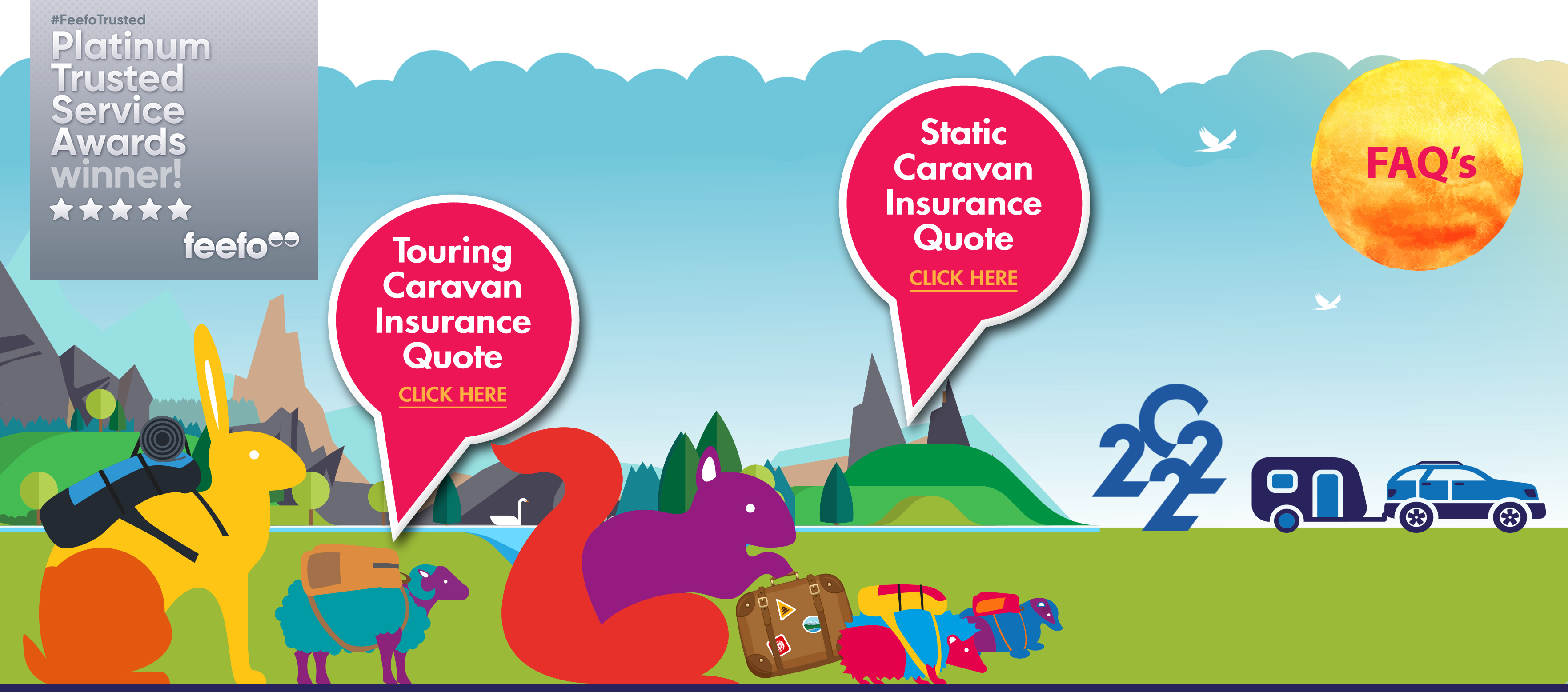Destination ideas for Summer!
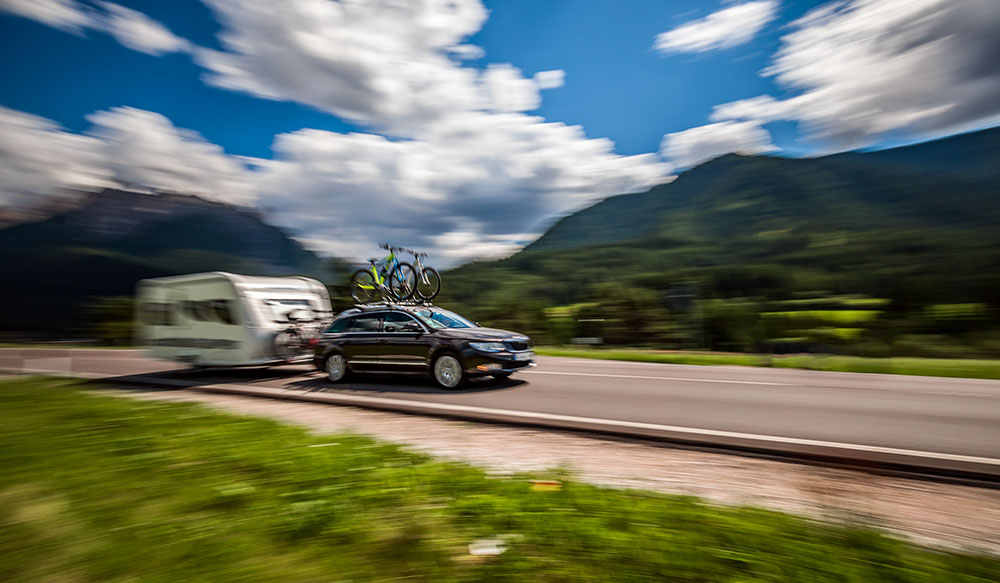
If you are a caravanner, you have better reason than many to plan for those good times ahead – the time when you can hitch up the ‘van, take to the roads, and explore pastures new or long-time favourites.
So, here are some destination ideas for the Summer to whet your appetite!
Kent
Not for nothing is this corner of the country described as the Garden of England. The orchards, hop fields and verdant landscape make Kent a county to visit at any time of the year but in particular in the summertime.
In addition to the quiet and peaceful countryside, Kent has more than its fair share of castles and historic monuments, fantastic beaches – some of the best in Europe, according to the local tourist board – and a treasure trove of family entertainment.
The Camping and Caravanning Club campsite at Canterbury makes an ideal base from which to explore the whole county.
Southwest England
There can be only few seasoned caravanners who do not already know the lure of Devon and Cornwall. If you are new to the pastime, you might soon discover the attraction.
An extensive and varied coastline offers mile upon mile of stunning walks and trails, there are any number of glorious beaches with water sports for the more adventurous, and you can escape to the more remote and tranquil corners of rural England inland.
You’ll be spoilt for choice when it comes to choosing somewhere to pitch your caravan. It may be among the smaller sites, but Magic Cove Touring Park – between Padstow and Newquay on Cornwall’s north coast – has just the name to conjure up the allure of the west country at its best.
When the sun is out, of course, the natural place to head towards is the beach – where glistening sands and shimmering seas hold out the prospect of cooling breezes. But even on cooler days, the fantastic views and rugged landscape can be enjoyed.
In Devon, the Camping and Caravanning Club’s Slapton Sands campsite is situated on the impressive South Devon Heritage Coast and makes the perfect base for a family holiday by the beach.
The New Forest
Of course, you might want to play it completely safe and get the best of both worlds – the beach and the sea if the weather forecasts prove accurate, but somewhere more sheltered when unpredictability brings in the rain.
That makes the New Forest an ideal location – offering sheltered woodland walks if it turns to rain, but the nearby south coast beaches of Boscombe, Highcliffe and Hordle when the sun and sea beckon.
The Caravan and Motorhome’s New Forest Caravan Club Centenary Site is set just a mile or two from the village of Bransgore, with forest walks in one direction and beaches in the other!
The Lake District
Also likely to stay cooler than any pitch near the beach, the Lake District remains an all the year-round favourite with caravanners – and for good reason too.
The lakes themselves provide a perfect setting in which to pitch your tourer and, after a drop or two of rain, the rugged majesty of the peaks and fells are softened to a glorious green.
Park Cliffe Touring Park is a stone’s throw from the largest of the lakes, Windermere, and the section for touring caravans is on a slight hill to maximise the lakeside views from hardstanding pitches which come with 10-amp electric hook-ups.
Mid Wales
Both North and South Wales have their steadfast caravanning champions – so why not break the mould and visit Mid Wales?
Mid Wales offers you paths and trails less visited – and some breath-taking views along the way. Whether you choose to sit back and take these in from under the shade of your tourer’s awning or take to horseback, a mountain bike, or good old shank’s pony, Mid Wales holds many a treat in store.
Fforest Fields, near Llandrindod Wells, in Powys, offers a mixture of all-weather, hard-standing and grass pitches in a peaceful and tranquil setting, with free use of canoes and kayaks on the nearby lake.
Yorkshire Dales
Kick back and enjoy and altogether quieter pace of life as you pitch your caravan on one of the many sites in the Yorkshire Dales.
You can be certain of a more peaceful and more relaxed break away from home than the beaches to the east or even the ever-popular Lake District to the west. The Yorkshire Dales offer the perfect escape from it all.
For beautiful views across the whole of Wharfedale and the prospect of outings to Bolton Abbey and Skipton, pitch your caravan at the Howgill Lodge Caravan Park.
Northern Ireland
Once you’ve boarded the ferry, it’s almost like venturing forth on some foreign holiday – with the blessing that everyone still speaks English.
Make Northern Ireland your destination this summer and you’ll be likely to claim a holiday that’s different to many taken by the caravanning fraternity. Rolling farmland and valleys, rugged coastlines and historic castles and monuments all put their unique stamp on the province.
At the end of a busy day’s exploring, retire to your touring pitch at Ballyness Caravan Park, near Bushmills, Coleraine and Portrush on the coast.
Scotland
Yet another “foreign” holiday within the British Isles is just north of the border into Scotland.
It’s a big country, too, that deserves a whole chapter all to itself if you are planning your next summer holidays.
For now, then, let’s just suggest that you first make yourself the welcome guest of Scottish hospitality in the Border Country at the Melrose Gibson Park Caravan Club Site near Melrose in the scenic Eilden Hills.
From the far southwest to the north of the British Isles – and everywhere in between – you can be assured of variety and contrasts wherever you take your touring caravan.
For many caravanning families, of course, sun, sea and sand might not be all they’re cracked up to be, and cooler climes in more majestic settings may be the order of the day.
Loch Lomond is probably one of the most recognised destinations when you travel north of the border and Lomond Woods Holiday Park is a beautiful place to pitch up.
Or you might want to visit Loch Ness Shores in Scotland – it offers a total of 99 pitches and is one of the few places along the shores of the famous loch where you can launch small boats.
For more destination inspiration, check out some of our Guides here.
Why use a caravan awning?
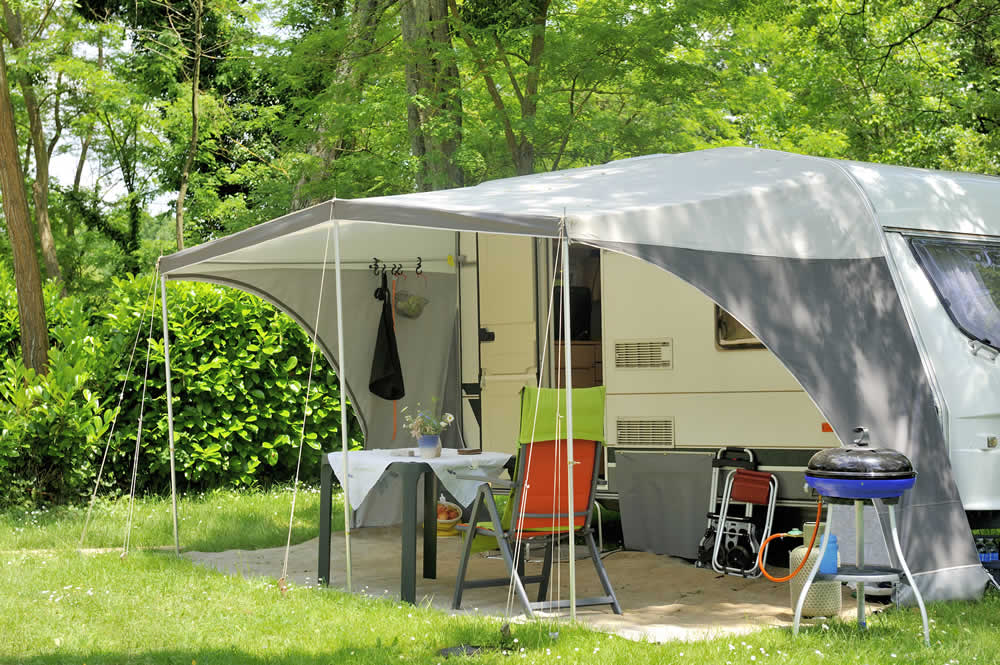
However much you might love your tourer, static caravan, or motorhome there’s always likely to be something that could be improved. Nine times out of ten, that’s probably going to pick up on the inevitable shortage of space in your home away from home.
If that happens to be your issue, at least there’s something that can be done about it – you’ll not have to just grin and bear it by accepting that cramped living conditions are part and parcel of any caravanning holiday. After all, the smaller and lighter weight your caravan, the easier it is to tow up hill and down dale.
The solution
One obvious solution, therefore, is to invest in an awning for your caravan. The versatility of an awning is demonstrated by the many different uses they serve:
- the additional space which it is always helpful to spill over into, even if you have quite a large caravan;
- as a place to store additional pieces of kit and equipment which might otherwise clutter the interior of the caravan;
- a “wet room”, where you can shrug off wet clothing and muddy boots when the weather turns foul;
- when weather conditions are unpredictable, an awning offers shelter from rain, wind, and intense sun, allowing you to enjoy outdoor activities regardless of the weather;
- an awning creates a private outdoor space, which can be useful in crowded campsites. It provides a secluded area where you can relax without feeling exposed to other campers;
- modern awnings come with modular features, allowing you to customise the space according to your needs. You can add or remove panels, or use it as a sleeping area etc.;
- an awning can help ventilate your caravan, reducing condensation and keeping the interior fresh. You can leave windows and doors open without worrying about rain getting inside;
- with the added shelter and comfort an awning provides, you can extend your camping season into the cooler months, making the most of your investment in your caravan;
- as a shady retreat when the sun is high – but still open to gentle breezes if the awning’s walls are rolled up; and
- choosing an awning with a little individual taste and style and it may even be a way of putting a distinctive personal touch to your touring or static caravan.
For a more detailed consideration of these and other benefits, you might want to review our Guide to Awnings about buying, installing and using your awning.
These days, they come in all shapes and sizes and typically consist of a steel or aluminium framework over which a waterproof cover is stretched. They can no longer be looked upon as being just a glorified tent.
They come with windows and zippable doors and can easily be fitted onto the frame of your caravan. You may find that your awning can double the living space your caravan provides and might be a more cost-effective and flexible way of increasing your living space than buying a bigger caravan would be.
Types of awning
What makes an awning still more versatile is that it may be bought in assorted sizes and designs to suit a range of different purposes:
- a full awning, for example, typically runs the full length of your caravan, to which it is attached by the built-in channel of the caravan itself – your handbook normally specifies the length of this channel, making it easy to determine the size of the awning you need;
- a full awning may even give you the option of creating a tent within a tent – also known as a “pup tent” for use as an additional bedroom;
- a porch awning, on the other hand, is a more compact version and may be appropriate if payload weight is an issue when towing a touring caravan;
- lighter still is a straightforward sun canopy, which might extend the full length of the caravan but is designed simply to provide shade and may or may not come with removable side walls or those which may be rolled up out of the way.
If you cannot afford a new awning or simply want to try one out before committing to such a purchase, there are a number of websites – including Preloved Caravan Awnings, to name just one – where you might find an appropriately affordable deal.
If you are planning to buy a used awning, of course, it repays to give it a careful inspection, paying particular attention to any tears in the canvas and ensuring that seams are still watertight.
Awning insurance
With so many potential uses and versatility, it may be easy to imagine how your awning quickly becomes an indispensable piece of kit.
As with anything you do not want to go without for long, awning insurance, therefore, may be seen as a priority – such a priority that we have devoted a blog all about the subject entitled Awning insurance: need to know.
The problem is that not all caravan insurance providers may offer cover for awnings at all, and you’ll typically find that those that do might attach specific terms and conditions to their cover.
It may be sensible, therefore, when looking at caravan insurance, to compare what provision is or is not made. At Cover4Caravans for example, our policies typically have a separate listing on your policy schedule relating to your awning.
This is needed because while it may, of course, be very tempting to regard the additional space that an awning provides as just another part of your caravan, it is a separate and less secure structure.
You might wish to keep in mind therefore that even the most sophisticated awnings may be easy prey for thieves and that there may be specific conditions laid out in your policy document, including:
- the contents of your awning, apart perhaps for camping tables and chairs, might not be covered at all; while
- storm damage to the awning might only be covered if you are using it at the time that it happens.
It may simply be plain common sense to get into the habit of not keeping any valuables under the awning and of stowing it away when you are not actually present at the caravan itself.
If you need further help or advice on cover for awnings or what your obligations are, please feel free to contact us.
Llanberis Touring Park Site Review
Date of Visit: First May Bank Holiday Weekend 2024
Overall View
This is a 54-pitch site, 19 of which are fully serviced. The site is situated on the edge of the village of Llanberis, Lake Padarn in North Wales. It is part of the Morris Leisure Group, www.morris-leisure.co.uk Members of the CAMC receive a discount when using their parks. It is generally open from beginning of March to beginning of January each year. Arrival is permitted after 1pm, there is very limited parking should you arrive too far in advance of this time. Departure is between 8.30am and 12 noon.
Access is good from the A55 to the North, East and West. The A5 is available from the South but it is highly recommended that you use the A55 if towing a caravan. Please see site arrival video HERE
The non-service pitches are closer to the main road into Llanberis and, as result, there is some road noise. However, it is only at specific times of the day, and we did not find it too intrusive. Serviced pitches are further away from the road and are not subject to the same level of noise.
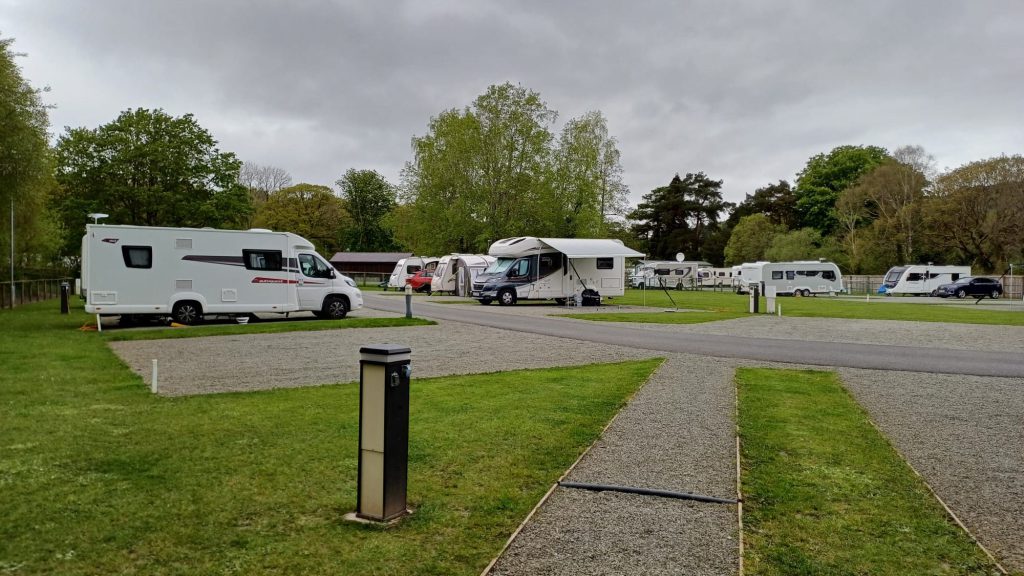
Facilities
This is a full facilities site with a facilities block at the entrance. It consists of the usual services, toilets, showers, small shop, reception, laundry and fully accessible shower room. Entrance is via a key with a separate key for the disabled access room.
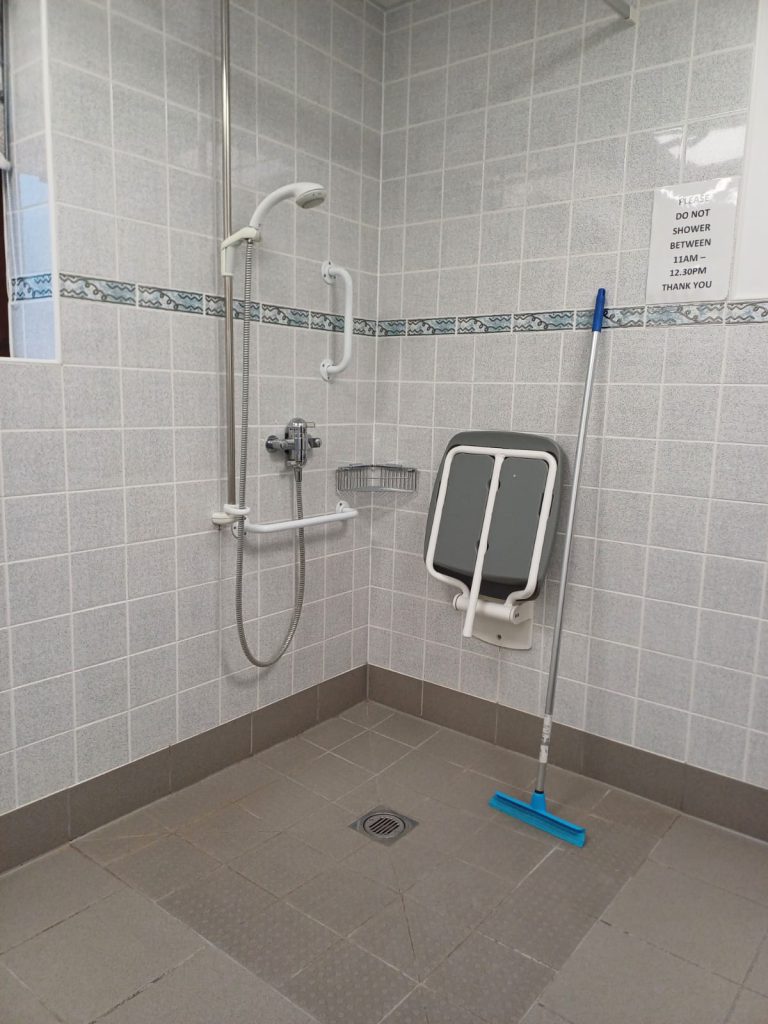
Security is very strong here with key fob operated barriers on entering or leaving the site. The barriers are locked between 11pm and 7am each night.
There is free on-site Wi-Fi and on test showed 10.2Mbps download speed and an upload speed of 10Mbps.
EE showed a strong performance at 5G and Vodafone at 4G.
There is a good dog walk to one side of the site and this also encompasses the short pathway from the site direct to the bottom end of the High Street.
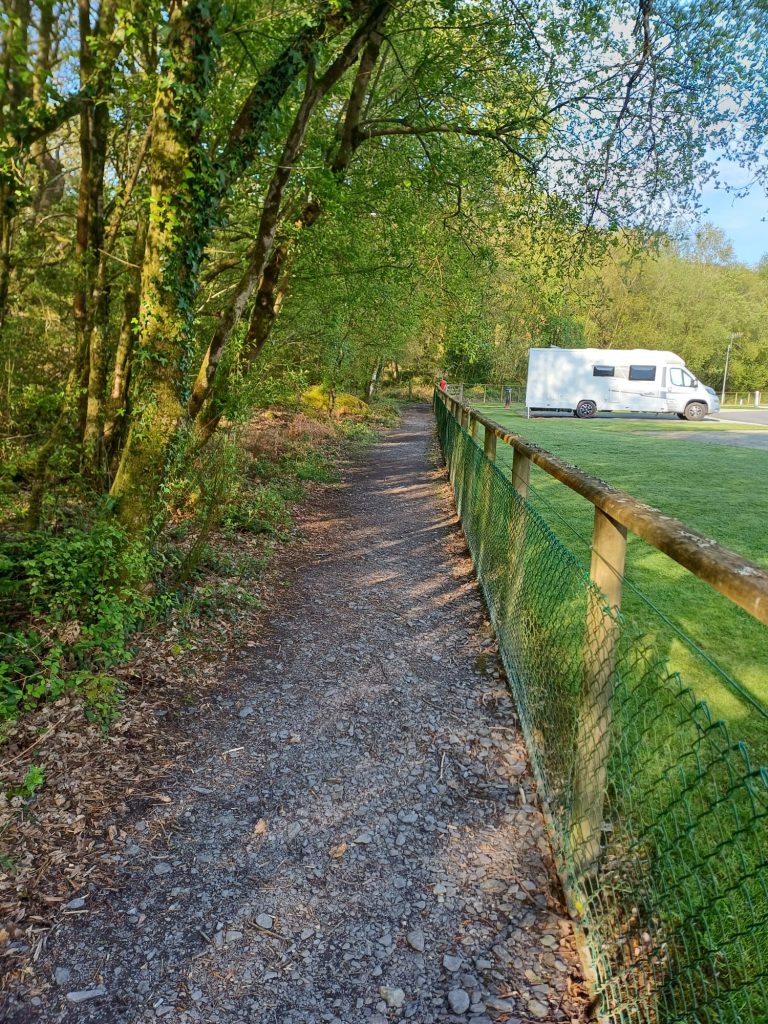
Motorhomes are well catered for with a drive over service point and general use service points are distributed around the site.
A food van visited whilst we were there over the bank holiday weekend, they offered the usual range of fast food, including vegan offerings. These times do vary so you are best advised to check with the Wardens on arrival. We did not try the food on this occasion, in part as their prices were somewhat expensive.
There is a bus service which operates in the area, https://www.gwynedd.llyw.cymru/en/Residents/Parking-roads-and-travel/Bus-timetables/Bus-timetables.aspx and there are services to Bangor, and this is where the nearest National Railway station is. Connections are to Holyhead on the Isle of Anglesey and ferries to Dublin, and Chester and beyond in the other direction. Direct trains do run to London Euston, but it is essential you check the timetables as services do change frequently. www.nationalrail.co.uk
Review of Site Pitch
The pitch was of the usual generous proportions and level. They use the peg system similar to the CAMC sites. There was ample space to park the caravan, awning and a car. Wider or larger awnings may require you to park the car in front of the van & awning but there is sufficient space to do so. The grass areas surrounding the pitches is kept to a very high standard. There is a 16-amp bollard, and you are recommended to use the TV booster point here too. We were able to receive a good amount of channels, including the Welsh language service.
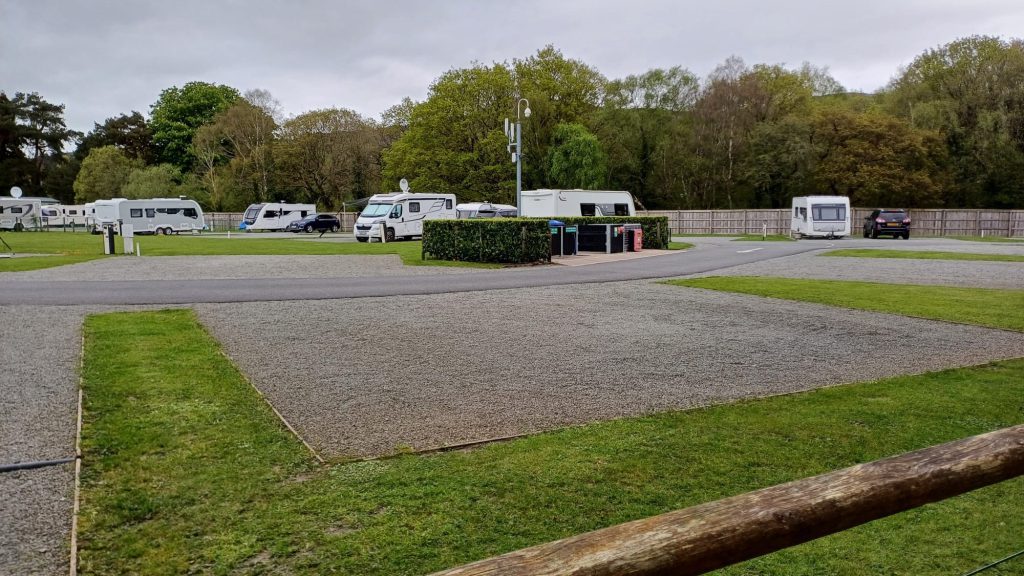
Around and about
Llanberis is a small village, situated in the foothills of Snowdon. It is due to this that the village can become very busy and congested as a result. This is serious hiking, mountain biking, cycling and other adventure sports countryside. https://www.visitsnowdonia.info/llanberis
The small High Street has a couple of pubs, takeaways and a One-Stop shop. There is no petrol station in the village itself although you will pass a Texaco garage on the way to the site. The nearest supermarket is Tesco in Bangor – a twenty minute or so drive and just off the A55. Tesco has a fuel station.
At the opposite end of the village from the site is the starting point for the Snowdon Mountain Railway. You are strongly advised to book ahead as it does get very busy, especially when the weather is clear. Dogs are not allowed on the train, other than assistance dogs.
Llyn Padarn is a lake which is used by the Port Dinorwigg Power Station, (aka Electric Mountain). Guided tours are available and there is a very interesting visitor centre explaining how the whole system works. Good facilities for young people too. It is possible to kayak on the lake as well. The lake also has two further attractions to offer, as well as some level walking trails. https://snowdoniawatersports.com/
The first one is the Lyn Padarn Lake Railway – this is a miniature railway with fully enclosed carriages if required. It runs from the main station at the far side of the lake from the village. There is ample paid parking here, blue badge holders are exempt. The station also has a cafe and a visitor information room. Toilets are available for customers. Again, as most of these attractions are on the coach tours itinerary they can be very booked up – booking ahead is advised.
The second attraction, across the road from the railway is the National Slate Museum for Wales. This was free to enter when we visited, and dogs are allowed apart from the inside of the period houses. It has a cafe, toilets and a gift shop. It was well patronised, and the exhibits were both interesting and thought provoking. It is not necessary to book in advance for this.
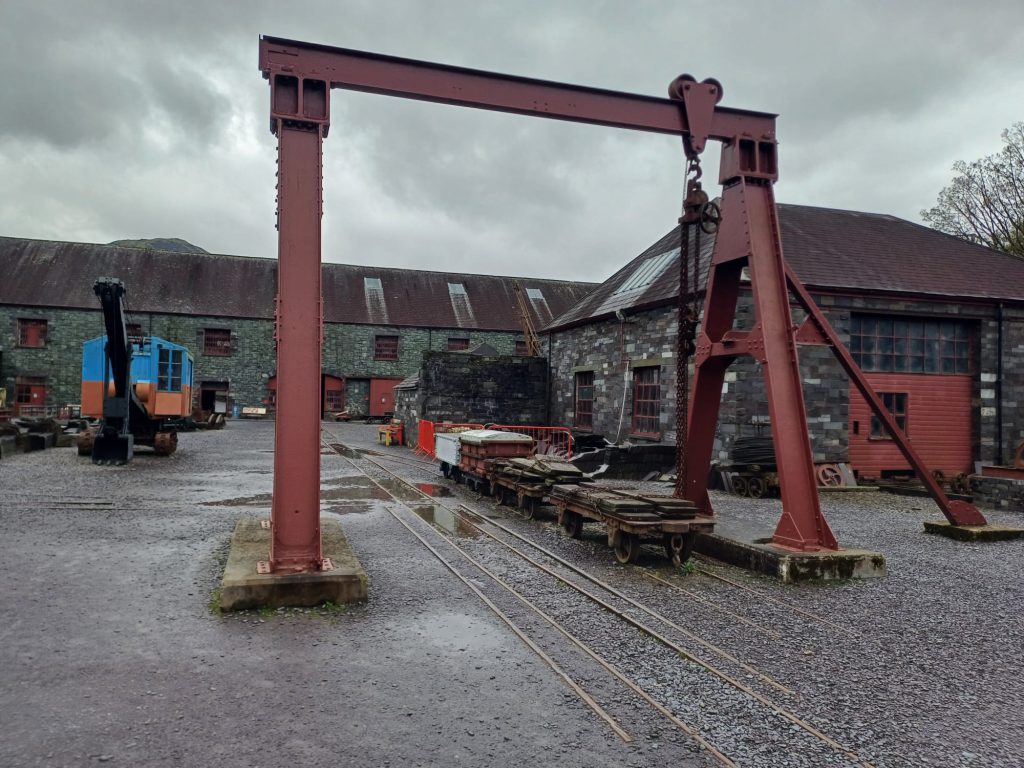
In between these two attractions is a Wi-Fi hotspot and a small range of craft shops and an independent coffee shop. There is seating outdoors under a weatherproof veranda and we can highly recommend their coffee and Bara Brith, (a traditional Welsh fruit cake eaten with butter slathered over it). There are also a set of public toilets with a fully accessible toilet if required.
Slightly further afield, both pretty equidistant – 20-25 minutes’ drive, depending upon traffic are the towns of Bangor and in the other direction Caernarfon. It is here where you will find the usual bigger stores and services.
During our short visit we went to Bangor and opted to take a stroll on the pier, entrance fee payable, dogs are allowed. There is a car park, (pay as part of entrance fee) and toilets although not a disabled one by the entrance. It has been restored a great deal over recent years but sadly some of the little shops are still suffering in the post COVID era. There is a cafe right at the end with outdoor seating, the leeward side being most populated! You are ¾ of the way across the Menai Straits at this point and the wind can certainly howl down the Straits between the mainland and Anglesey. On a clear day, as it was when we visited, it possible to see the old Menai Bridge in one direction, Beaumaris and the Great Orme in the other. https://bangorpier.org/
Summary
A very smart, well-presented site as you would expect from Morris Leisure. The site is easily accessible which makes it an ideal destination for both a short and longer stay if you wish. There are a good range of attractions and activities, but nightlife is very limited indeed. It is a site to which we would return.
Pop-up at Holkham, National Camping and Caravanning Week, and watch your speed!

This is the time of year that caravanners new and old, seasoned and beginners, hitch up the ‘van, take to the high road, and pitch up at their favourite campsite or explore pastures new.
If that is you, you’ll want to set out when you’re abreast of the latest UK caravan news – so, here is a brief selection of some of the headlines …
CAMC’s pop-up campsite to return to Holkham Hall
Book your pitch by the end of May, use a special code, and you’ll earn yourself a 10% discount on your stay at the popular Holkham Hall pop-up site to be opened once again this year (from the 16th of August until the 13th of September 2024) announced Practical Caravan recently.
That’s not the only saving you’re likely to make by setting up camp at this iconic site in the heart of some of Norfolk’s most popular attractions. If you’re staying here, you also qualify for a 30% discount on the price of entry to the magnificent Holkham Hall itself, its 6-acre walled gardens, and a tour of Holkham Stories – an immersive and interactive tour of the Hall’s past, present, and future.
Holkham Hall is just a mile inland from the inviting north Norfolk coastline, close to the Holkham National Nature Reserve and Holkham Beach – opportunities for walking, hiking, and cycling are boundless.
Celebrate National Camping and Caravanning Week
Monday the 27th of May until Sunday the 2nd of June is the National Camping and Caravanning Week hosted by the Camping and Caravanning Club.
It’s an opportunity to celebrate everything about enjoying the pleasures of the outdoor life, including a chance to connect with nature, its flora and fauna, and the serenity of simple daily events such as the sun going down in its unique blaze of glory. All in all, these are the moments designed to increase the regular caravanners’ sense of well-being.
This year’s special week is also a celebration of the recent inauguration of the Camping and Caravanning Club’s new President Hamza Yassin. He will be putting in at least one personal appearance at the Blackmore Club Site in the Malverns – and further events are scheduled to take place at other sites across the country.
DVSA warns hundreds of drivers over speed limit changes
As the new caravanning season gets underway, the Driver and Vehicle Standards Agency (DVSA) has warned those with a caravan in tow to watch their speed – and, specifically, to keep within the limits for vehicles pulling a caravan.
A story in the Birmingham Mail on the 21st of April reminded motorists that when you have a caravan in tow, you are restricted to 30mph in all built-up areas (remembering that in some places – Wales in particular – that limit could be reduced to just 20mph).
On single-carriageways outside built-up areas, the speed limit is 50mph, rising to 60mph on dual-carriageways and motorways.
It’s worth taking heed of these warnings – exceed the speed limit and you could find yourself with up to six penalty points on your driving licence.
Caravanning in the Cotswolds
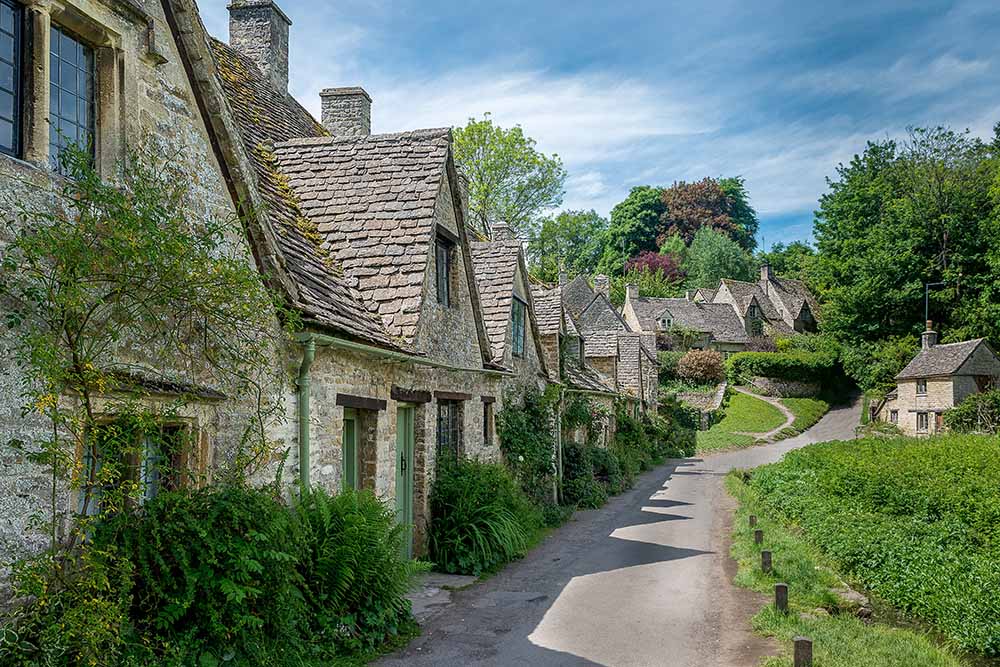
There are very good reasons why so many of the rich and famous have homes in this place. The Cotswolds are at the very heart of England and offer a quintessential idyll of all that’s comfortably easy in a countryside lifestyle.
Caravanning in the Cotswolds
But you don’t have to live there to enjoy these many and varied delights – it is a haven for caravanners. So, where can you find the Cotswolds and what can you do once you get there?
The Cotswolds cover a surprisingly large area – a total of 790 square miles (2,038 square kilometres) with land in no less than six counties (Bath and NE Somerset, Oxfordshire, Gloucestershire, Warwickshire, Wiltshire, and Worcestershire). This makes it the biggest Area of Outstanding Natural Beauty (AONB) and the third-largest protected terrain in England.
Things to do
Towns and villages
Thanks to the large tracts of land included within the Cotswolds, there are a host of attractive and historic English towns to visit. Among them, you will find tourist hotspots such as Bath, Cirencester, Stow-on-the-Wold, Cheltenham, Stratford-upon-Avon, Bristol, Oxford, and Swindon.
The real treasures, however, are probably away from the major settlements and are instead found in the smaller, picture-postcard villages of honey-stoned cottages such as Bilbury, Burford, Bourton-on-the-Water, and many, many others.
History
Given its place at the very heart of England, it is hardly surprising that the Cotswolds also include its share of historic estates, castles, and monuments.
While history buffs will be swotting up on all the important dates and events, other visitors to places such as Berkeley Castle, Blenheim Palace, and Sudeley Castle can engage in the gentler pursuit of simply admiring the timeless architecture and marvelling at the beautiful gardens.
Activity
But your visit needn’t be all stately and sedate – the Cotswolds offer a glorious stage for all manner of activities, adventures, and exercise.
You might want to try exploring the quiet country lanes on a bicycle or even walk the length of the Cotswold Way – the full trail winds an impressive 102 miles (164km) between Chipping Campden in Gloucestershire to the Roman city of Bath in Somerset. The route is not only scenic but will give you a real sense of stepping back in time as you pass through its historic villages, ancient woodlands, and rolling hills.
Whether you’re a beginner or well-acquainted with equestrian sports, horse riding is another way of enjoying this gem of rural England.
Festivals and events …
As you arrange your itinerary of visits to the wealth of market towns throughout the Cotswolds, remember that a host of events and festivals are held throughout the year at many of these places.
One of the best-known is the Cheltenham Literature Festival but there are other, quirkier events such as the Tetbury Woolsack Races, the Moreton Show for a traditional agricultural and horse show proudly hosted by the town of Moreton-in-the-Marsh. Or even the – positively hair-raising and neck-breaking Gloucestershire Cheese Rolling competition down the 200 yard (180m) drop of Coopers Hill.
… and relax!
Remind yourself that you’re at home with the rich and famous when you visit the Cotswolds. So, that means a spot of pampering will not go amiss.
As befits those who will have plenty of leisure time on their hands, spas and wellness centres are dotted throughout the Cotswolds and offer the opportunity to unwind in tranquil surroundings and luxuriate in indulgences ranging from full body treatments, to massages, and facials.

